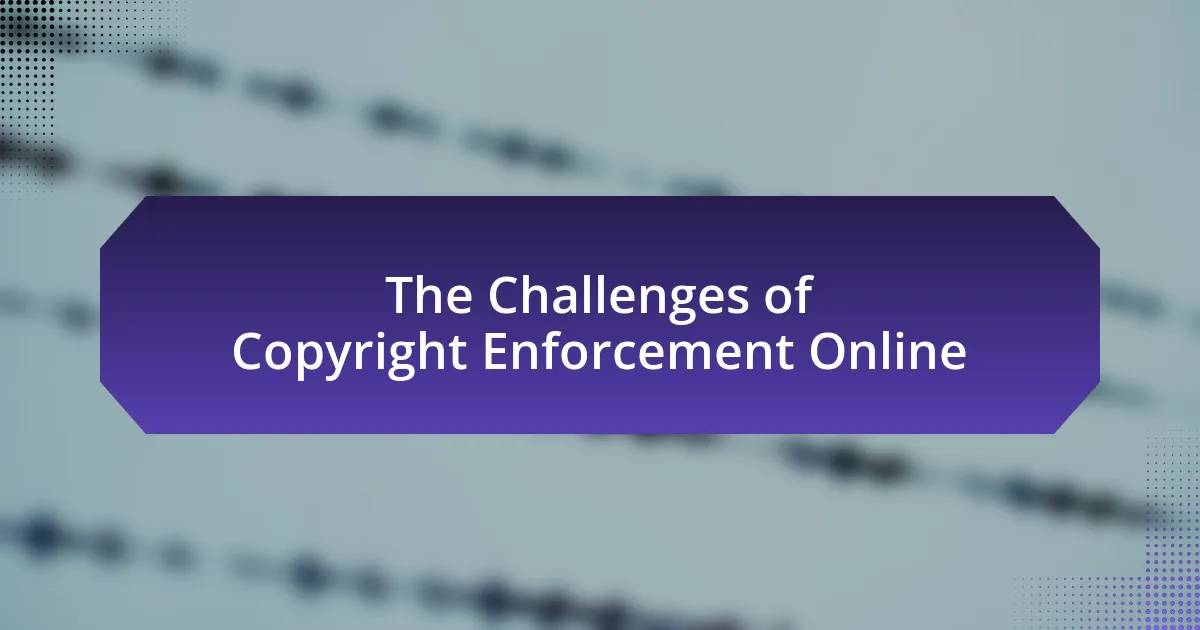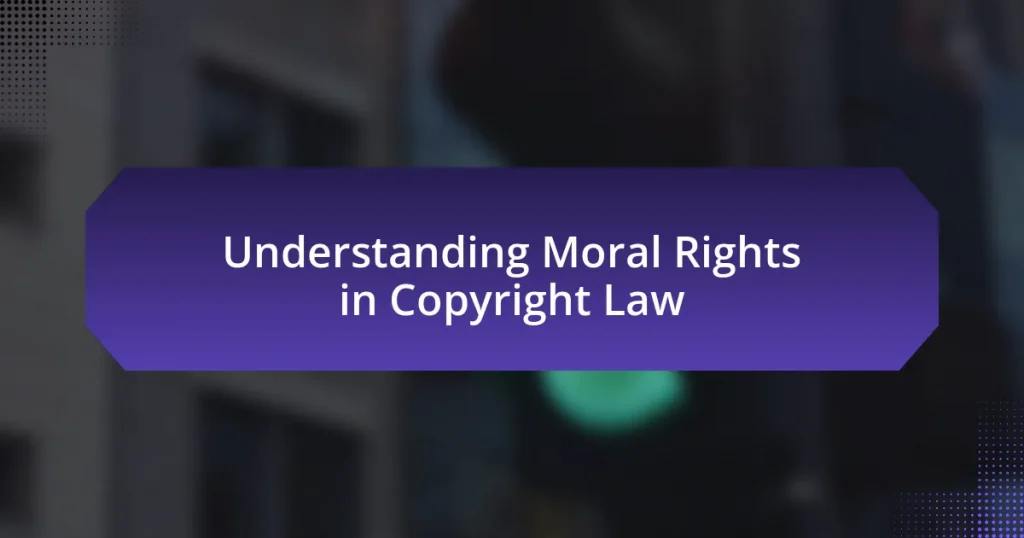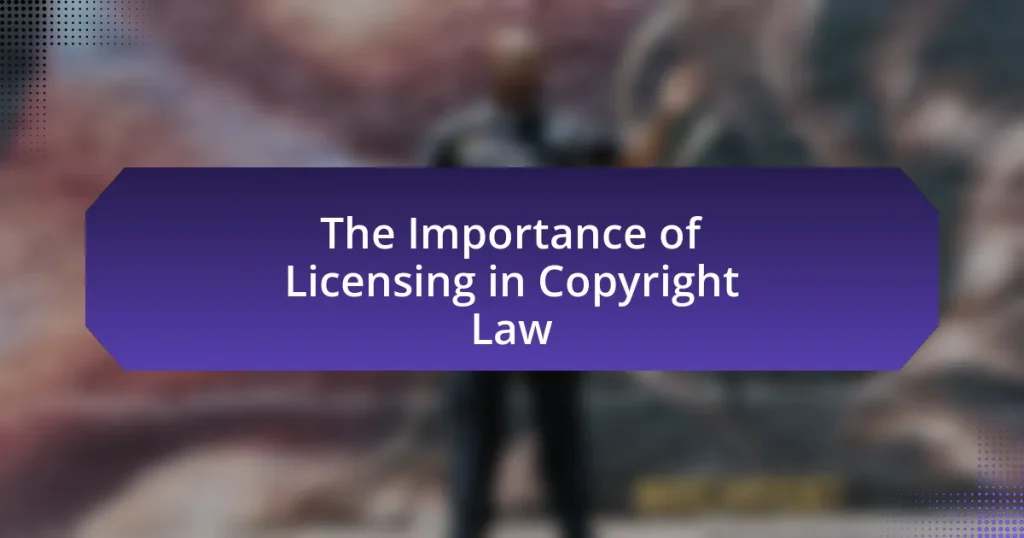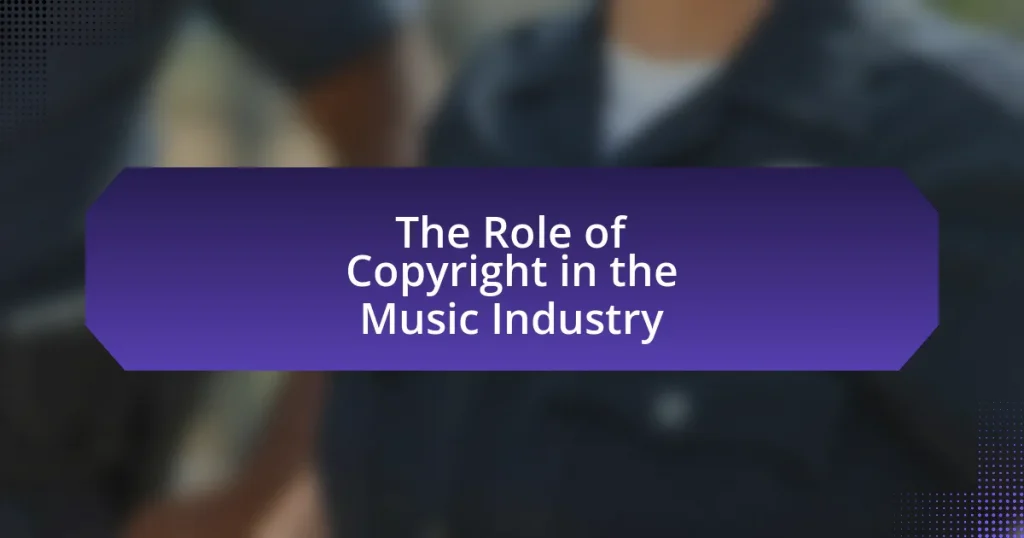The article examines the challenges of copyright enforcement online, highlighting issues such as the difficulty in identifying infringers, the rapid pace of content sharing, and jurisdictional complexities due to the internet’s global nature. It discusses how user-generated content platforms complicate enforcement and the impact of anonymity on identifying copyright violations. Additionally, the article explores the limitations of current copyright detection technologies, the economic implications of piracy on content creators, and the effectiveness of legal frameworks like the Digital Millennium Copyright Act (DMCA). Finally, it addresses technological advancements in copyright protection and best practices for content creators to safeguard their work in the digital landscape.
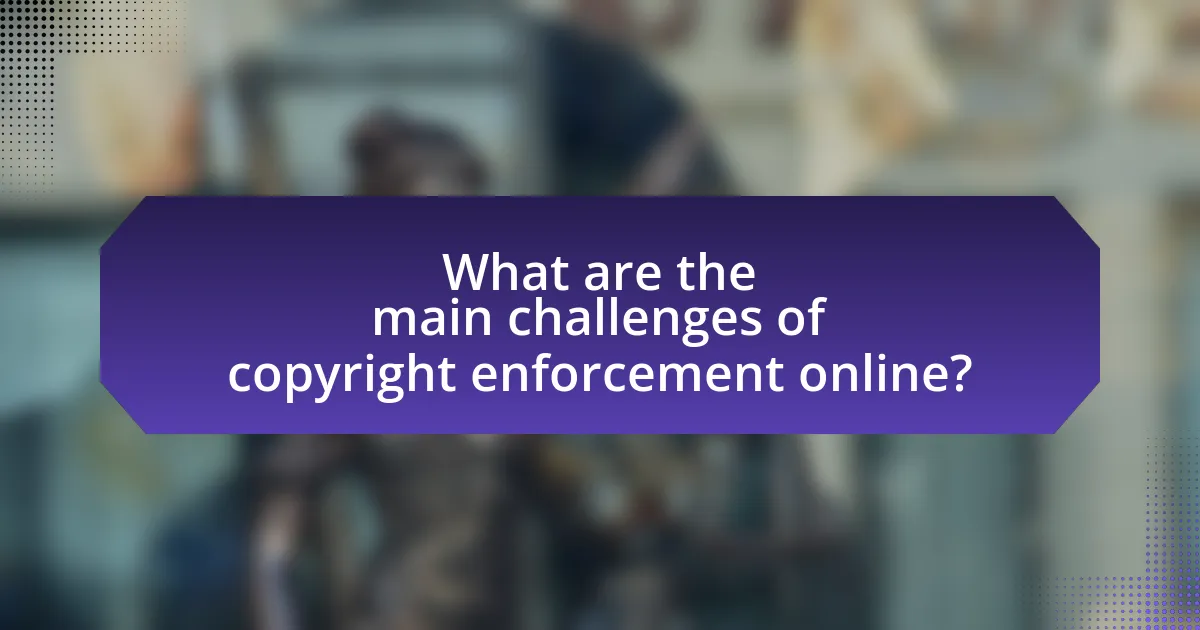
What are the main challenges of copyright enforcement online?
The main challenges of copyright enforcement online include the difficulty in identifying infringers, the rapid pace of content sharing, and the jurisdictional issues that arise from the global nature of the internet. Identifying infringers is complicated due to the anonymity provided by online platforms, making it hard for copyright holders to track down violators. The rapid sharing of content across various platforms often leads to widespread infringement before any enforcement action can be taken. Additionally, jurisdictional issues complicate enforcement, as copyright laws vary significantly between countries, making it challenging to pursue legal action against infringers located in different jurisdictions. These factors collectively hinder effective copyright enforcement in the digital landscape.
How does the digital landscape complicate copyright enforcement?
The digital landscape complicates copyright enforcement by enabling widespread and rapid distribution of copyrighted material, often without authorization. The internet allows users to easily share, copy, and modify content, which makes it difficult for copyright holders to track and control their intellectual property. For instance, a study by the European Union Intellectual Property Office in 2020 found that 29% of internet users reported accessing pirated content, highlighting the scale of unauthorized distribution. Additionally, the anonymity provided by online platforms further complicates enforcement, as identifying infringers can be challenging. These factors collectively undermine traditional copyright protections and enforcement mechanisms.
What role do user-generated content platforms play in copyright issues?
User-generated content platforms significantly influence copyright issues by serving as intermediaries between content creators and users. These platforms often host a vast array of user-uploaded material, which can include copyrighted works without proper authorization. This situation complicates copyright enforcement, as platforms may face liability for infringing content unless they comply with the Digital Millennium Copyright Act (DMCA) safe harbor provisions. Under the DMCA, platforms can avoid liability by promptly removing infringing content upon notification from copyright holders. This legal framework highlights the dual role of these platforms: they facilitate creative expression while also necessitating mechanisms for copyright protection and enforcement.
How does the ease of content sharing affect copyright protection?
The ease of content sharing significantly undermines copyright protection by facilitating unauthorized distribution of copyrighted materials. This widespread sharing occurs through various platforms and social media, where users can easily upload, share, and access content without proper licensing or attribution. For instance, a study by the European Union Intellectual Property Office in 2020 found that 29% of internet users reported accessing pirated content, highlighting the prevalence of copyright infringement due to easy sharing mechanisms. Consequently, this ease of access complicates enforcement efforts, as tracking and identifying infringers becomes increasingly challenging in a digital landscape where content can be rapidly disseminated and replicated.
Why is it difficult to identify copyright infringement online?
Identifying copyright infringement online is difficult due to the vast amount of content and the ease of copying and distributing digital materials. The internet allows users to share files rapidly, often without proper attribution or awareness of copyright laws. Additionally, the anonymity provided by online platforms complicates enforcement, as infringers can hide their identities. According to a report by the U.S. Copyright Office, the sheer volume of user-generated content on platforms like social media and streaming services makes it challenging for copyright holders to monitor and enforce their rights effectively. This combination of factors creates a complex environment for identifying and addressing copyright infringement.
What are the limitations of current copyright detection technologies?
Current copyright detection technologies face several limitations, including difficulties in accurately identifying derivative works and the challenge of distinguishing between fair use and infringement. These technologies often rely on algorithms that may not effectively recognize context, leading to false positives or negatives. For instance, a study by the Electronic Frontier Foundation highlights that automated systems struggle with nuanced cases, such as parody or commentary, which can fall under fair use. Additionally, copyright detection tools may not keep pace with the rapid evolution of content formats and distribution methods, resulting in gaps in enforcement capabilities.
How do anonymous users impact enforcement efforts?
Anonymous users significantly hinder enforcement efforts by obscuring their identities, making it difficult for authorities to track and hold them accountable for copyright infringement. This anonymity allows individuals to engage in illegal activities, such as piracy and distribution of copyrighted material, without fear of repercussions. For instance, a study by the European Union Intellectual Property Office found that the prevalence of anonymous file-sharing networks complicates the identification of infringers, thereby reducing the effectiveness of legal actions against copyright violations. Consequently, the lack of identifiable information about anonymous users creates substantial barriers for enforcement agencies in their pursuit of compliance and accountability in copyright law.
What legal frameworks exist for online copyright enforcement?
The primary legal frameworks for online copyright enforcement include the Digital Millennium Copyright Act (DMCA) in the United States, the European Union’s Copyright Directive, and the Berne Convention for the Protection of Literary and Artistic Works. The DMCA, enacted in 1998, provides a safe harbor for online service providers, allowing them to avoid liability for copyright infringement if they promptly remove infringing content upon notification. The EU’s Copyright Directive, implemented in 2019, aims to enhance copyright protection in the digital environment, requiring platforms to take proactive measures against copyright infringement. The Berne Convention establishes international standards for copyright protection, obligating member countries to recognize and enforce copyright laws across borders. These frameworks collectively address the complexities of enforcing copyright in the online space, balancing the rights of creators with the operational realities of digital platforms.
How do international copyright laws differ in enforcement?
International copyright laws differ in enforcement primarily due to variations in national legislation, judicial systems, and international treaties. For instance, the Berne Convention mandates minimum standards for copyright protection but allows countries to implement their own enforcement mechanisms, leading to inconsistencies. Additionally, the Digital Millennium Copyright Act in the United States provides specific provisions for online copyright enforcement that differ from the European Union’s Copyright Directive, which emphasizes user rights and fair use. These differences can result in varying levels of protection and enforcement capabilities across jurisdictions, impacting how copyright infringement is addressed globally.
What are the implications of the Digital Millennium Copyright Act (DMCA)?
The implications of the Digital Millennium Copyright Act (DMCA) include the establishment of a framework for copyright protection in the digital environment, which significantly impacts how copyright infringement is addressed online. The DMCA provides safe harbor provisions that protect internet service providers and platforms from liability for user-generated content, provided they comply with takedown requests. This has led to increased compliance costs for platforms and has raised concerns about the potential for abuse of the takedown process, where legitimate content may be removed erroneously. Additionally, the DMCA has influenced the development of digital rights management technologies, shaping how content is distributed and accessed online.
How do economic factors influence copyright enforcement online?
Economic factors significantly influence copyright enforcement online by determining the resources available for monitoring and legal action against infringement. For instance, companies with larger budgets can invest in advanced technologies and legal teams to track and enforce their copyrights, while smaller entities may lack the financial means to pursue enforcement effectively. According to a report by the International Intellectual Property Alliance, the economic impact of piracy on the U.S. economy was estimated at $29 billion in lost revenue in 2019, highlighting the financial stakes involved in copyright enforcement. Additionally, the cost of litigation can deter copyright holders from pursuing cases, especially when potential damages may not outweigh legal expenses. Thus, economic considerations directly shape the effectiveness and frequency of copyright enforcement actions online.
What is the impact of piracy on content creators and industries?
Piracy significantly harms content creators and industries by reducing their revenue and undermining their ability to invest in new projects. According to a report by the Institute for Policy Innovation, piracy costs the U.S. economy approximately $29.2 billion annually, affecting jobs and innovation in creative sectors. This loss of income leads to fewer resources for creators, which can stifle artistic development and diminish the quality and quantity of content produced. Furthermore, piracy creates an uneven playing field, where legitimate businesses struggle to compete with free, illegal alternatives, ultimately threatening the sustainability of the entire industry.
How do enforcement costs affect small businesses versus large corporations?
Enforcement costs disproportionately burden small businesses compared to large corporations. Small businesses often operate with limited financial resources, making it challenging to allocate funds for legal compliance and enforcement actions. In contrast, large corporations typically have more substantial budgets and dedicated legal teams, allowing them to absorb enforcement costs more easily. For instance, a study by the U.S. Small Business Administration found that small businesses spend approximately 36% more of their revenue on regulatory compliance than larger firms, highlighting the financial strain enforcement costs impose on them. This disparity can lead to small businesses being less able to defend against copyright infringement, ultimately affecting their competitiveness and sustainability in the market.
What technological solutions are being developed to aid copyright enforcement?
Technological solutions being developed to aid copyright enforcement include digital rights management (DRM) systems, content identification technologies, and blockchain-based tracking. DRM systems restrict the use and distribution of copyrighted material, ensuring that only authorized users can access it. Content identification technologies, such as YouTube’s Content ID, automatically detect and manage copyrighted content uploaded to platforms, allowing rights holders to monetize or block unauthorized uses. Blockchain technology offers a decentralized ledger for tracking ownership and usage rights, providing transparency and security in copyright management. These solutions collectively enhance the ability to enforce copyright laws in the digital landscape.
How effective are automated content recognition systems?
Automated content recognition systems are highly effective in identifying copyrighted material across various platforms. These systems utilize advanced algorithms and machine learning techniques to analyze audio and video content, achieving accuracy rates often exceeding 90% in detecting copyrighted works. For instance, YouTube’s Content ID system has successfully identified and managed billions of copyrighted videos, demonstrating the capability of automated systems to enforce copyright effectively. Additionally, studies indicate that these systems can significantly reduce instances of copyright infringement, thereby supporting content creators in protecting their intellectual property rights.
What advancements are being made in blockchain technology for copyright protection?
Advancements in blockchain technology for copyright protection include the development of decentralized platforms that enable creators to register and manage their intellectual property rights securely. These platforms utilize smart contracts to automate licensing agreements and ensure that creators receive royalties directly upon usage of their work. For instance, projects like Myco and Po.et are leveraging blockchain to create immutable records of ownership and usage, which can significantly reduce infringement and unauthorized use. Additionally, the integration of non-fungible tokens (NFTs) has provided a new way for artists to tokenize their work, allowing for clear provenance and ownership tracking. These advancements demonstrate a shift towards more transparent and efficient copyright management systems, addressing the challenges of enforcement in the digital age.
What best practices can content creators adopt to protect their work online?
Content creators can adopt several best practices to protect their work online, including using copyright notices, registering their work with copyright offices, and employing digital rights management (DRM) tools. Copyright notices serve as a clear indication of ownership and can deter unauthorized use. Registering work with copyright offices provides legal advantages, such as the ability to sue for statutory damages in case of infringement. Additionally, DRM tools help control access and distribution of digital content, making it harder for unauthorized users to copy or share the work. These practices are supported by copyright law, which grants creators exclusive rights to their original works, thereby reinforcing the importance of proactive measures in safeguarding intellectual property.
How can creators effectively use licensing agreements?
Creators can effectively use licensing agreements by clearly defining the terms of use for their work, which allows them to retain control over how their content is utilized. By specifying the scope, duration, and compensation in the agreement, creators can protect their intellectual property while enabling others to use it under agreed conditions. For instance, a study by the World Intellectual Property Organization highlights that well-structured licensing agreements can lead to increased revenue streams and broader distribution of creative works, demonstrating their importance in the digital landscape.
What strategies can be employed to monitor and enforce copyright online?
To monitor and enforce copyright online, strategies include the use of digital rights management (DRM) technologies, automated content recognition systems, and legal frameworks such as the Digital Millennium Copyright Act (DMCA). DRM technologies restrict unauthorized access and copying of digital content, while automated content recognition systems, like YouTube’s Content ID, identify and manage copyrighted material across platforms. The DMCA provides a legal mechanism for copyright holders to request the removal of infringing content, thereby facilitating enforcement. These strategies collectively enhance the ability to protect intellectual property rights in the digital environment.
